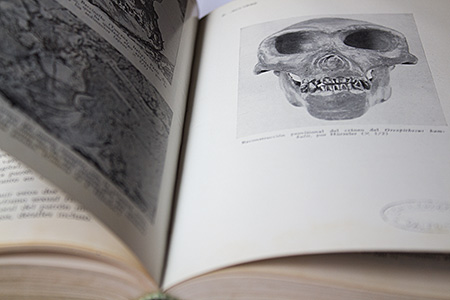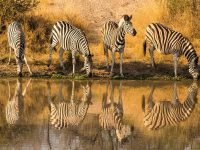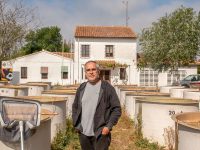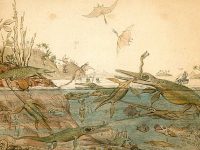The seed of ‘La Evolución’
The development of human palaeontology in Spain in recent decades

Human palaeontology in Spain has experienced extraordinary growth in recent decades. In this work we investigate the influence that the book La evolución (1966) and its editors, Miquel Crusafont, Bermudo Meléndez, and Emiliano Aguirre, exerted on this explosion. Two areas have developed significantly: the study of the Miocene hominoids, originally linked to Crusafont and the Vallès-Penedès basin sites (Barcelona), and the study of the first human occupations in Europe, closely related to Aguirre and the Atapuerca excavations (Burgos). Different factors have contributed to this progress, but the research inertia of La evolución and its conceptual foundations have been key to the development of the discipline.
Keywords: palaeontology, La evolución, palaeoanthropology, Atapuerca, excavation sites.
Since the time the foundations of an evolutionary conception of the world were laid at the beginning of the nineteenth century, research into the patterns and processes of human evolution, particularly its palaeontological dimension (palaeoanthropology), has developed rapidly in countries such as France, Great Britain, Italy, and the United States. Conversely, in Spain, research in this field has been dotted with ups, downs, and discontinuities, in addition to institutional disinterest. It has also been spurred on by researchers and talented professionals who are, nevertheless, isolated and lack the necessary resources (Aguirre, 1992). The result has been an inevitable one hundred-year delay in the discipline. Fortunately, this situation has been overcome in recent years (Pelayo, 2013) and Spain is now an international leader in different areas of palaeontology.
«La evolución was the seed required for the explosion that palaeoanthropology would experience in Spain starting in the 1980s»
The recovery of that lost time has been a long and sustained process which began in the late 1970s (Aguirre, 1992) and different social, political, and economic factors have influenced this phenomenon (Hochadel, 2013). However, the influence that «seminal works» have had on the development of scientific disciplines is well-recognised in the history of science (Gould, 2004). In this article we hypothesise that the publication of La evolución (“Evolution”; Crusafont, Meléndez, & Aguirre, 1966) presented research programs and scientific principles that have ended up playing a key role in the field of human palaeontology in Spain in recent decades.
A brief history of palaeoanthropology
A brief overview of the history of human palaeontology (Delisle, 2015; Tattersall, 1995) can provide us with the perspective to explore this proposed working hypothesis.
The events of the 1850s would later have foundational relevance for palaeoanthropology. The French geologist Jacques Boucher de Perthes established a first canon for the sequences of Palaeolithic industries, and in 1856 the remains from the Neander Valley (Germany) were discovered. This marked the point when the scientific discipline that studies the evolutionary origins of human beings (human palaeontology or palaeoanthropology) can be considered to have initiated. Three years later, in 1859, Charles Darwin published the first edition of On the origin of species. The chronological coincidence of these events would later connect most of the concepts of evolution to that of human fossils. Supported by the ideas of Thomas Huxley and Ernst Haeckel, an evolutionary model was established, providing a framework for «where to look for» fossils from our ancestors. The race for the discovery of evidence for human evolution had begun. From that early period, we have the contributions of Juan Vilanova y Piera (Aguirre, 1992) which include the discovery of the first human fossils found in Spain, from Cova del Parpalló, and the 1872 publication of the book Origen, naturaleza y antigüedad del hombre (“Origin, nature, and antiquity of man”).
In 1894, Eugène Dubois is credited with one of the discipline’s greatest achievements – the discovery of the first fossils from the river Solo in Java, denominated Pithecanthropus erectus. Shortly afterwards, in 1927, the remains of the «Beijing man» were excavated in Choukoutien (China). In the early twentieth century, seminal publications were printed, one after another, especially those written by Anglo-Saxon authors, and these provided a foundation for the study of human evolution.
In the meantime, Europe accumulated a generous list of findings. In France, classical fossils were discovered that would mark the ideological foundations of the discipline, such as the Cro-Magnon man (1868) and the Neanderthals of La Chapelle-aux-Saint (1908). In present-day Croatia, the discovery of Krapina’s ancient Neanderthals marked the beginning of an era. The Piltdown remains were found in England in 1912 and these were highly influential until they were revealed as a fraud. The Saccopastore remains in Italy and the Spy remains in Belgium made it possible to definitively associate Mousterian industries with the anatomy of Neanderthals. Shortly afterwards, British researchers discovered the remains of Tabun and Skhul in the Middle East. In 1924, the skull of the Taung Child was discovered in South Africa, opening the door to Africa, which was definitively consolidated with the discovery of Homo habilis in Olduvai (Tanzania) in 1960. Overall, these findings constitute the foundations of palaeoanthropology and are still an obligatory reference for new research (Rosas, 2015).
Among all these discoveries, Spain contributed with isolated findings of the Upper Palaeolithic or later ages. Other discovered remains include those from the cave of La Paloma (Asturias) and El Castillo (Santander), along with the jaw from Banyoles (1887) as the main human palaeontological trophies. Later that century it was joined by a parietal bone from Cova Negra (Valencia) and the remains from Carigüela in Piñar (Granada). In 1912, the Junta de Ampliación de Estudios (JAE, “Board for the Extension of Studies”) undertook a serious institutional endeavour to address issues related to the origin of man with the formation of the Comisión de Investigaciones Prehistóricas y Paleontológicas (CIPP, “Commission for Prehistoric and Palaeontological Research”). Under its patronage, the palaeontologist Hugo Obermaier published Der fossile Mensch (“The fossil man”) in 1916. But another fifty years had to pass for La evolución to be published.
Throughout this process, the institutional stance was confusing and especially discontinuous. The absence of truly relevant and influential fossils did not help to promote studies or alleviate the usual lack of vision in scientific matters. In addition, the research focus at the turn of the century shifted towards the study of rock art as a manifestation of the centuries-old tendency of Spanish culture towards art and «humanities». Overall, human palaeontology in Spain has, historically, been little institutionalised; these relationships depended mostly on isolated figures, and their connection to research networks often ended with these individuals.
However, something changed in the late 1960s. The Human Palaeontology Section at the Lucas Mallada Institute of the Consejo Superior de Investigaciones Científicas (CSIC, “Spanish Scientific Research Council”) was created. It was born from the fragmentation of the National Museum of Natural Sciences after the Spanish Civil War and was headed by Emiliano Aguirre. At the editorial level, the Biblioteca de Autores Cristianos (BAC) published La evolución, a compilation and synthesis in which human evolution and its fossil record take on a central importance.

The book La evolución, published by Crusafont, Meléndez, and Aguirre (1966) presented research programs and scientific principles that ended up playing a key role in the field of human palaeontology in Spain in recent decades. / Iris Lafita
The fundamentals of La evolución
We can offer two very different perspectives on the book La evolución. On the one hand, it appears to be an old-fashioned book from a different time, with little scientific value; perhaps a historical curiosity. On the other hand, one should recognise the seminal function of the book, bursting with seeds for the future development of evolutionism in Spain. I certainly align myself with this perspective, but I want to go further and propose that La evolución was the seed required for the explosion that palaeoanthropology would experience in Spain starting in the 1980s.
La evolución encompasses a very broad conception of the evolutionary process and addresses all kinds of biological aspects. It supports a key principle: evolution is not a hypothesis, it is not a theory or a doctrine, it is simply a fact. Thus, the facts are not confused with the evolutionary mechanisms proposed to explain them, or with how the processes take place and at what scales they occur. Apart from its current validity, it is worth mentioning the well-founded theoretical treatment of the laws of evolution, included in the treatise on palaeontology by Bermudo Meléndez and studied by generations of palaeontologists.
There are two ideological and scientific poles at the heart of La evolución: one can be included under the banner of classical orthogenetic theories and the other is derived from modern ideas originating from synthetic theory created after World War II. But the book also includes novel ideas such as the concept of macroevolution, which years later would become a sort of bridge between both ideological extremes (Gould, 2004).
The work has a clear palaeontological influence, and with good reason, because its three editors were palaeontologists. Considering the historical context of Franco’s regime, the epistemological attitude of the editors is commendable. They offer a strictly empirical approach, dissociating the different spheres of human life in their discourse: the biological, the physical, the psychic or spiritual – there was no doubt a great deal of concern about the two latter aspects.
There was a yearning to put human beings into a global context. The book took a very broad theoretical approach and discussed whether the general principles of evolution were applicable to human beings. In this sense, the great contribution of La evolución to the field of palaeoanthropology, and hence its great historical significance, is that it contains an authentic review of the position of the human species in the context of organic evolution. Precisely because of its socio-political context rooted in National Catholicism, which is ideologically opposed to a non-divine origin for human beings, its approach to human evolution could not be partial or superficial. The stakes were high: it had to be a total, holistic approach full of concepts and aware of their implications. Therein lies the great depth of La evolución.
Of course, the book contains a series of ideas that we consider outdated today. Specifically, the idea of orthogenesis or directionality in evolutionary processes, or the teleology underlying Teilhard de Chardin’s ideas on human evolution, which were very influential at the time: seeing the evolutionary process as the ascent to a summit in which man would reach the peak of progress. Although reworked in evolutionary terms, the book also explicitly reflects the idea of a culmination of the hominid family into a single species. This is undoubtedly an ancient and stubborn idea, which emanates from the Bible and repeatedly permeates the western ideological substrate. Indeed, is the title of the book La especie elegida (“The chosen species”, Arsuaga & Martínez, 1998) not a recent manifestation of this concept?
The success of human palaeontology in Spain
The rise of Spanish palaeoanthropology in recent decades was based on two chronological and ystematic approaches, already mentioned in La evolución. On the one hand, the study of Miocene apes as a more remote substratum of human evolution, and on the other, the study of the fossils of the human family itself. Both approaches have been exceptionally successful and were inspired by Miquel Crusafont in the first case and Emiliano Aguirre in the second.
In the case of hominoids, Crusafont’s palaeontological and conceptual precedents are essential. At the Miquel Crusafont Institute of Palaeontology in Sabadell, currently attached to the Catalan Institute of Palaeontology (ICP), fossil remains from 12.5 to 11.5-million-year-old primates have been discovered and analysed, and new taxa, including Pierolapithecus catalaunicus, Anoiapithecus brevirostris, and Pliobates cataloniae, created (Moyà-Solà, Köhler, Alba, Casanovas-Vilar, & Galindo, 2004).
With Spanish palaeoanthropology’s relatively regular publication in high-impact journals, it has truly succeeded in breaking local inertia to achieve a solid international presence. Apart from the industry of scientific publications and their hidden interests, these journals (Nature, Science, Cell, PNAS, etc.) provide unparalleled dissemination of scientific results.
The study of fossils belonging strictly to the human family undoubtedly finds its current precedent in the figure of Emiliano Aguirre. Here, we aim not to outline his work or biography (see Baquedano & Rubio, 2002; Soria & Morales, 2002) but rather, to highlight La evolución and its future repercussions. Perhaps because he was not properly an orthodox Neo-Darwinist but kept his mind open to almost any idea, even beyond schools or fashion trends, his impact on the discipline is hard to match. The work of Emiliano Aguirre succeeded in achieving precisely that key variable absent from the preceding history of Spanish palaeoanthropology: continuity.
«The field of scientific dissemination is one of the areas in which the explosion of Spanish palaeoanthropology has been most noticeable»
In the light of his influence, we may wonder if the figure of Emiliano Aguirre, rather than the influence of La evolución itself, was the true driving force behind the subsequent development of palaeoanthropology: his individual charisma, rather than the collective work. We would be wrong to assign Emiliano Aguirre that role exclusively, however prominent he may have been. The three editors of La evolución have all provided elements fundamental to the development of the discipline. While Aguirre always provided the available empirical documentation, Crusafont directed his scientific thinking towards the more philosophical implications of anthropogenesis. For his part, Meléndez, a palaeontologist, focused on the study of invertebrates and gives key university-level support to studying the phenomenon of human evolution, by teaching and promoting subjects linked to human palaeontology. This is one of the reasons I think that this volume contains the seed that would lead to the subsequent development of the discipline.
The Atapuerca phenomenon
The complete chronicle of Atapuerca can be read in different texts (Carbonell & De Castro, 2004). In 1976 the first human remains were discovered at Sima de los Huesos. Emiliano Aguirre, aware of their importance, immediately published a first evaluation and requested funding for their study. Thus, the Atapuerca Project was born with the 1978 excavations, in which Josep Fernández de Villalta also played an important role.
There is a first stage of exploration undertaken by collaborators from the Lucas Mallada Institute. Eudald Carbonell, from Girona (Spain), entered the scene with an excavation method and a philosophy for the socialisation of science, inherited from a French tradition magnified by Henry de Lumley. In 1983, a new generation of students emerged who would later become, to a large extent, the scientific backbone of the project during the launching years. In 1993 the description of the unearthing of three skulls from Sima de los Huesos was published: Nature recognised its importance by putting it on their cover. Emiliano Aguirre retired, and the project was given to Eudald Carbonell, José María Bermúdez de Castro, and Juan Luis Arsuaga. The work continued, also thanks a to the encouragement of some others who would end up occupying positions in academic institutions throughout the country. A new model of associated management was also initiated.
In 1997, Science published the proposal for a new species, Homo antecessor, whose analysis was carried out at the Spanish National Museum of Natural Sciences, in a sense, as a continuation (although without formal entity) of the Human Palaeontology Section founded by Aguirre. This milestone represents what the anthropologist Bernard Wood called the «debut» of Spanish palaeoanthropology. Later, other accomplishments followed, and another peak was reached in 2008 with a second cover in Nature, which compiled the discovery of human fossils more than a million years old at Sima del Elefante. Publications in scientific journals of all sorts within the broad multidisciplinarity spectrum inherent to the research programme were constant. Undoubtedly, the project was unparalleled in the history of Spanish science.

Iris Lafita
Perhaps its most notable social recognition came with the Prince of Asturias Award for Scientific and Technical Research in 1996. The Atapuerca Project unfolded in the socio-political context of Spanish democratic restoration, its institutional spirit makes it the offspring of the Transition and its pioneering young spirit and search for quality overlaps with the fragrance of the Madrilenian music scene. At this time, during its first and most difficult stages, the project received economic and institutional support: the figures of Roberto Fernández de Caleya in the central administration and Enrique Baquedano in the autonomous region of Castile and León stood out thanks to their vision for the future. Funding for the excavation and multidisciplinary research of fossils and sites has continued to this day, with the support of the media (Hochadel, 2013; Pelayo, 2013). The Royal House has also played a passive but primary inducing role in the final positive reception of Atapuerca. The visionary dedication of the first monographic volume of these sites to Queen Sofía initiated good relations, with visits to the sites by the monarchy and newly created institutions.
Neanderthals
Paradoxically, the great contribution made to the general model of human evolution by the study of Atapuerca’s Mesopleistocene hominines was to determine their phylogenetic position as direct ancestors of the Neanderthals. Faced with this result, the centuries-old lack of Neanderthal fossil deposits in Spain became even more evident, and investigating this human species represented an almost urgent collective need to consolidate their standing on the international scene.
«Undoubtedly, the three editors of ‘La evolución’ had a powerful influence on generations of palaeontologists»
In 1966, the year in which La evolución was published, there were hardly any relevant Neanderthal remains in Spain. Fifty years later, the situation is radically different. Sites such as El Sidrón, La Sima de las Palomas, Cova Negra, Bolomor, El Romaní, and Lezetxiki, among others, have provided good collections. In recent years, new excavation techniques have been developed for the extraction of old DNA (Fortea et al., 2008): a field of study that was completely unimaginable only a decade ago and has led to the identification of new human lineages (such as Denisovans). In this context, the participation of Spanish scientists in the publication of the Neanderthal genome is particularly noteworthy (Green et al., 2010). The truth is that, on this occasion, Spanish palaeoanthropology did arrive on time.
Twenty-first-century human palaeontology in Spain
In the current editorial field, if we take the specialised Journal of Human Evolution as a reference, Spain is third in terms of its number of publications. Several Spanish authors have been associate editors and, in 2017, a Spanish scientist, David Martínez Alba, became editor of the publication for the first time.
The field of scientific dissemination is one of the areas in which the explosion of Spanish palaeoanthropology has been most noticeable. There are already numerous high-quality dissemination texts dealing with different aspects and approaches in the areas of palaeoanthropology and prehistory. Specifically referring to the case of Atapuerca, this fact has been considered as a phenomenon in itself and has been studied by historians of science (Hochadel, 2013).
Academic development has also been remarkable. Supported by the precedents from the universities of Madrid and Barcelona, many Spanish universities have prepared courses and master’s degrees in subjects related to human evolution, including the Rovira i Virgili University in Tarragona and the University of Burgos. In direct relation to this, we have also witnessed unprecedented institutional development in recent years. The creation of new centres such as the Centro Nacional de Investigación sobre la Evolución Humana (CENIEH, “National Centre for the Study of Human Evolution”) and the Museum of Human Evolution, both in Burgos; the Institut Català de Paleoecologia Humana i Evolució Social (IPHES, “Catalan Institute of Paleoecology and Social Evolution”) in Tarragona; the Joint Centre for Research on Human Evolution and Behaviour at the Complutense University of Madrid, and the Carlos III Health Institute; or the Catalan Institute of Palaeontology in Barcelona, which includes the Miquel Crusafont Museum in Sabadell.
The participation of scientists in international palaeoanthropological projects, with many personal or collective collaborations in projects around the world (including China, South Africa, Kenya, and Ethiopia) is also noteworthy. The Spanish-managed team that excavated multiple sites in the legendary Olduvai (Tanzania), which is also responsible for the construction of a field station named after Emiliano Aguirre, also deserves a special mention. Moreover, there is also significant participation in the research of human and mammal fossils from Dmanisi (Georgia), as well as recent exploratory expeditions to countries such as Eritrea and Equatorial Guinea.
References
Aguirre, E. (1992). Paleontología humana en España. In E. Molina (Ed.), Origen y Evolución del Hombre (pp. 11–36). Zaragoza: Universidad de Zaragoza.
Arsuaga, J. L., & Martínez, I. (1998). La especie elegida. La larga marcha de la evolución humana. Temas de Hoy: Barcelona.
Baquedano, E., & Rubio, S. (Eds.). (2002). Emiliano Aguirre. Obra selecta (1957-2003). Madrid: Museo Arqueologico Regional.
Carbonell, E., & De Castro, J. M. B. (2004). Atapuerca, perdidos en la colina: La historia humana y científica del equipo investigador. Destino: Barcelona.
Crusafont, M., Meléndez, B., & Aguirre, E. (Eds.). (1966). La evolución. Madrid: Biblioteca de Autores Cristianos.
Delisle, R. (2015). Debating humankind’s place in nature, 1860-2000: The nature of paleoanthropology. London: Routledge.
Fortea, J., de la Rasilla, M., García-Tabernero, A., Gigli, E., Rosas, A., & Lalueza-Fox, C. (2008). Excavation protocol of bone remains for Neandertal DNA analysis in El Sidrón Cave (Asturias, Spain). Journal of Human Evolution, 55(2), 353–357. doi: 10.1016/j.jhevol.2008.03.005
Gould, S. J. (2004). La estructura de la teoría de la evolución. Tusquets: Barcelona.
Green, R. E., Krause, J., Briggs, A. W., Maricic, T., Stenzel, U., Kircher, M., . . . Pääbo, S. (2010). A draft sequence of the Neandertal genome. Science, 328(5979), 710–722. doi: 10.1126/science.1188021
Hochadel, O. (2013). El mito de Atapuerca: Orígenes, ciencia, divulgación (vol. 7). Barcelona: Servei de Publicacions de la Universitat Autònoma de Barcelona.
Moyà-Solà, S., Köhler, M., Alba, D. M., Casanovas-Vilar, I., & Galindo, J. (2004). Pierolapithecus catalaunicus, a new Middle Miocene great ape from Spain. Science, 306(5700), 1339–1344. doi: 10.1126/science.1103094
Pelayo, F. (2013). Antes de Atapuerca. La paleontología humana en España durante la dictadura de Franco. In L. Calvo, A. Giron & M. A. Puig-Samper (Eds.), Naturaleza y laboratorio (pp. 323–349). Barcelona: Residència d’investigadors CSIC-Generalitat de Catalunya.
Rosas, A. (2015). Los primeros homininos. Paleontología humana. Madrid: Catarata-CSIC.
Soria, D., & Morales, J. (2002). Emiliano Aguirre Enríquez: Notas biográficas. Zona Arqueológica, 2, 12–45.
Tattersall, I. (1995). The fossil trail: How we know what we think we know about human evolution. New York, NY: Oxford University Press.
Acknowledgements
This work was framed within the development of the project CGL2016-75109-P.
Note
This text is partly based on the conference La simiente de ‘La evolución’, delivered by the author at the International Conference «La evolución tras La evolución» (Valencia, Spain, 26–28 October 2016).





